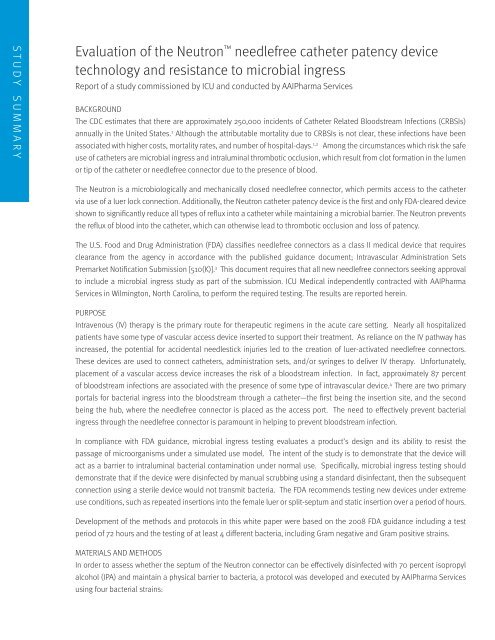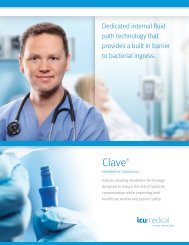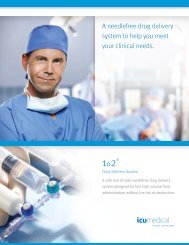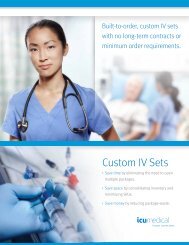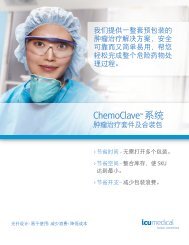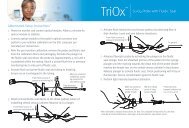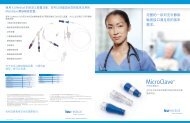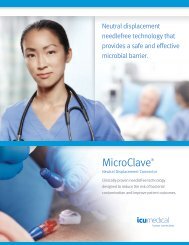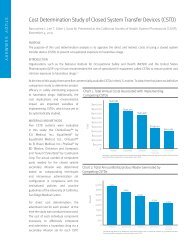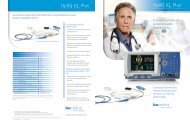Evaluation of the Neutron™ needlefree catheter ... - ICU Medical, Inc.
Evaluation of the Neutron™ needlefree catheter ... - ICU Medical, Inc.
Evaluation of the Neutron™ needlefree catheter ... - ICU Medical, Inc.
Create successful ePaper yourself
Turn your PDF publications into a flip-book with our unique Google optimized e-Paper software.
S T U D Y S U M M A R Y<strong>Evaluation</strong> <strong>of</strong> <strong>the</strong> Neutron <strong>needlefree</strong> ca<strong>the</strong>ter patency devicetechnology and resistance to microbial ingressReport <strong>of</strong> a study commissioned by <strong>ICU</strong> and conducted by AAIPharma ServicesBACKGROUNDThe CDC estimates that <strong>the</strong>re are approximately 250,000 incidents <strong>of</strong> Ca<strong>the</strong>ter Related Bloodstream Infections (CRBSIs)annually in <strong>the</strong> United States. 1 Although <strong>the</strong> attributable mortality due to CRBSIs is not clear, <strong>the</strong>se infections have beenassociated with higher costs, mortality rates, and number <strong>of</strong> hospital-days. 1,2 Among <strong>the</strong> circumstances which risk <strong>the</strong> safeuse <strong>of</strong> ca<strong>the</strong>ters are microbial ingress and intraluminal thrombotic occlusion, which result from clot formation in <strong>the</strong> lumenor tip <strong>of</strong> <strong>the</strong> ca<strong>the</strong>ter or <strong>needlefree</strong> connector due to <strong>the</strong> presence <strong>of</strong> blood.The Neutron is a microbiologically and mechanically closed <strong>needlefree</strong> connector, which permits access to <strong>the</strong> ca<strong>the</strong>tervia use <strong>of</strong> a luer lock connection. Additionally, <strong>the</strong> Neutron ca<strong>the</strong>ter patency device is <strong>the</strong> first and only FDA-cleared deviceshown to significantly reduce all types <strong>of</strong> reflux into a ca<strong>the</strong>ter while maintaining a microbial barrier. The Neutron prevents<strong>the</strong> reflux <strong>of</strong> blood into <strong>the</strong> ca<strong>the</strong>ter, which can o<strong>the</strong>rwise lead to thrombotic occlusion and loss <strong>of</strong> patency.The U.S. Food and Drug Administration (FDA) classifies <strong>needlefree</strong> connectors as a class II medical device that requiresclearance from <strong>the</strong> agency in accordance with <strong>the</strong> published guidance document; Intravascular Administration SetsPremarket Notification Submission [510(K)]. 3 This document requires that all new <strong>needlefree</strong> connectors seeking approvalto include a microbial ingress study as part <strong>of</strong> <strong>the</strong> submission. <strong>ICU</strong> <strong>Medical</strong> independently contracted with AAIPharmaServices in Wilmington, North Carolina, to perform <strong>the</strong> required testing. The results are reported herein.PURPOSEIntravenous (IV) <strong>the</strong>rapy is <strong>the</strong> primary route for <strong>the</strong>rapeutic regimens in <strong>the</strong> acute care setting. Nearly all hospitalizedpatients have some type <strong>of</strong> vascular access device inserted to support <strong>the</strong>ir treatment. As reliance on <strong>the</strong> IV pathway hasincreased, <strong>the</strong> potential for accidental needlestick injuries led to <strong>the</strong> creation <strong>of</strong> luer-activated <strong>needlefree</strong> connectors.These devices are used to connect ca<strong>the</strong>ters, administration sets, and/or syringes to deliver IV <strong>the</strong>rapy. Unfortunately,placement <strong>of</strong> a vascular access device increases <strong>the</strong> risk <strong>of</strong> a bloodstream infection. In fact, approximately 87 percent<strong>of</strong> bloodstream infections are associated with <strong>the</strong> presence <strong>of</strong> some type <strong>of</strong> intravascular device. 4 There are two primaryportals for bacterial ingress into <strong>the</strong> bloodstream through a ca<strong>the</strong>ter—<strong>the</strong> first being <strong>the</strong> insertion site, and <strong>the</strong> secondbeing <strong>the</strong> hub, where <strong>the</strong> <strong>needlefree</strong> connector is placed as <strong>the</strong> access port. The need to effectively prevent bacterialingress through <strong>the</strong> <strong>needlefree</strong> connector is paramount in helping to prevent bloodstream infection.In compliance with FDA guidance, microbial ingress testing evaluates a product’s design and its ability to resist <strong>the</strong>passage <strong>of</strong> microorganisms under a simulated use model. The intent <strong>of</strong> <strong>the</strong> study is to demonstrate that <strong>the</strong> device willact as a barrier to intraluminal bacterial contamination under normal use. Specifically, microbial ingress testing shoulddemonstrate that if <strong>the</strong> device were disinfected by manual scrubbing using a standard disinfectant, <strong>the</strong>n <strong>the</strong> subsequentconnection using a sterile device would not transmit bacteria. The FDA recommends testing new devices under extremeuse conditions, such as repeated insertions into <strong>the</strong> female luer or split-septum and static insertion over a period <strong>of</strong> hours.Development <strong>of</strong> <strong>the</strong> methods and protocols in this white paper were based on <strong>the</strong> 2008 FDA guidance including a testperiod <strong>of</strong> 72 hours and <strong>the</strong> testing <strong>of</strong> at least 4 different bacteria, including Gram negative and Gram positive strains.MATERIALS AND METHODSIn order to assess whe<strong>the</strong>r <strong>the</strong> septum <strong>of</strong> <strong>the</strong> Neutron connector can be effectively disinfected with 70 percent isopropylalcohol (IPA) and maintain a physical barrier to bacteria, a protocol was developed and executed by AAIPharma Servicesusing four bacterial strains:
Staphylococcus epidermidis, ATCC #12228> > Staphylococcus aureaus, ATCC #6538> > Klebsiella pneumonia, ATCC #4352> > Pseudomonas aeruginosa, ATCC #9027Twenty-four (24) test samples were prepared in addition to eight (8) negative control samples and eight (8) positivecontrol samples. Each sample device was subjected to 5 inoculations/disinfections/activations per 24-hour period for 3days. After <strong>the</strong> 15 th activation, 2 additional activations were performed: one four-hour “extended activation” and one finalactivation in which 10 mL <strong>of</strong> soybean casein digest broth (SCDB) with 5% deactivated bovine serum albumin was flushedthrough <strong>the</strong> device. Testing was performed per AAIPharma Protocol ICMS122809.Over a three-day period, this experiment utilized artificial contamination <strong>of</strong> <strong>the</strong> Neutron septum with inoculum level <strong>of</strong> atleast 10 3 organisms to simulate extreme-use conditions. Each sample was subjected to inoculation and allowed to dry forat least 1 minute, followed by standard hospital disinfection procedure using a 70% (IPA) prep pad and wiping vigorouslyin a circular motion for three seconds. This entire process was completed five (5) times per 24-hour period. After eachengagement, injectate through <strong>the</strong> connector was collected and tested for <strong>the</strong> presence <strong>of</strong> <strong>the</strong> challenge microorganisms.Positive controls included in this study were inoculated with <strong>the</strong> same number <strong>of</strong> organisms as <strong>the</strong> test samples, but werenot subjected to <strong>the</strong> disinfection process prior to activation. Negative controls included in this study were not inoculatedwith any <strong>of</strong> <strong>the</strong> challenge organisms, but were subjected to <strong>the</strong> same disinfection and activation processes as <strong>the</strong> sampleunits. All negative control samples were negative for ingress <strong>of</strong> any <strong>of</strong> <strong>the</strong> challenge organisms.RESULTSOf <strong>the</strong> four bacterial strains, <strong>the</strong> data indicates that zero (0) colony-forming unit (CFU) <strong>of</strong> each test organism passedthrough <strong>the</strong> septum <strong>of</strong> <strong>the</strong> Neutron <strong>needlefree</strong> connector for all 17 activations to which each <strong>of</strong> <strong>the</strong> 24 test samples weresubjected. (See Table.)TABLETest Organism Extended Activation (CFU) SCDB Flush (CFU) Positive ControlLog ReductionStaphylococcus epidermidis 0 0 3.3Staphylococcus aureaus 0 0 3.1Klebsiella pneumonia 0 0 3.1Pseudomonas aeruginosa 0 0 3.1CONCLUSIONIn all cases <strong>the</strong> microbial barrier <strong>of</strong> <strong>the</strong> Neutron <strong>needlefree</strong> ca<strong>the</strong>ter patency device effectively prevented microbial ingresswhen inoculated with at least 3 logs <strong>of</strong> organism and challenged under simulated extreme-use conditions, includingrepeated inoculation on <strong>the</strong> outer surface <strong>of</strong> <strong>the</strong> septum, disinfection, and activation over a period <strong>of</strong> 3 days. Fur<strong>the</strong>rmore,<strong>the</strong> results confirm that <strong>the</strong> Neutron microbial barrier meets <strong>the</strong> requirements delineated by <strong>the</strong> 2008 FDA guidancedocument Intravascular Administration Sets Premarket Notification Submissions [510(k)]. The Neutron may be consideredan effective tool to assist in <strong>the</strong> prevention <strong>of</strong> ca<strong>the</strong>ter hub contamination and o<strong>the</strong>rwise intraluminal bacterial colonization.References1. Blot SI, Depuydt P, Annemans L, et al. Clinical and economic outcomes in critically ill patients with nosocomial ca<strong>the</strong>ter-related bloodstream infections. Clin Infect Dis2005;41:1591-1598.2. Centers for Disease Control and Prevention. Reduction in central line-associated bloodstream infections among patients in intensive care units—Pennsylvania, April 2001–March 2005. MMWR Morb Mortal Wkly Rep 2005;54:1013-1016.3. Guidance for Industry and FDA Staff: Intravascular Administration Sets Premarket Notification Submission [510(K)]. 2005.4. Ryder, M. Ca<strong>the</strong>ter-related infections: It’s all about bi<strong>of</strong>ilm. Topics Adv Pract Nurse Journal. 2005 [cited 2006 Sept 11]; 5(3). Available www.medscape.com/viewarticle/508109.© 2012 <strong>ICU</strong> <strong>Medical</strong> <strong>Inc</strong>.M1-1313 Rev. 01


